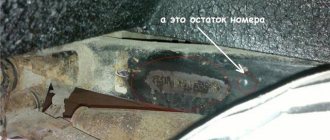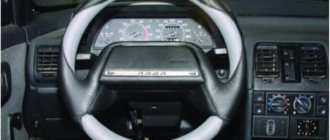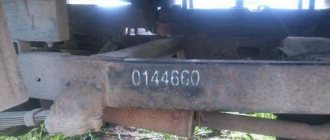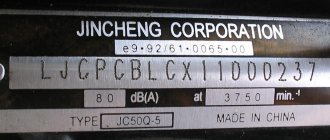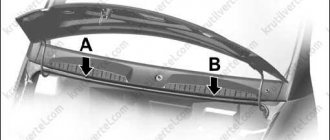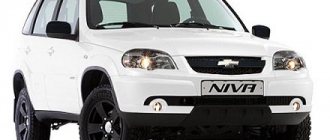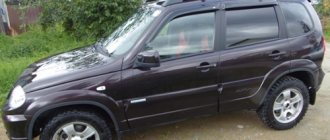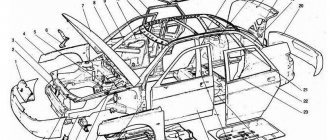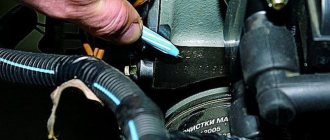Where to look for the VIN code
Most often, the VIN code can be found under the hood, in a special window with a barcode located on the windshield.
“Where is the body number on American cars?” - you ask. American cars are somewhat different from domestic and European cars. Often in an American car you can see the VIN code right on the dashboard on the driver’s side. It can be easily seen in the place where the hood and windshield meet. Duplicating the VIN code provides greater security against theft.
The traditional location of the body number is considered to be such parts as the cylinder block, the cylinder head, and the partition between the engine and the passenger compartment. On vehicles with a frame structure, the manufacturer applies this code to the side members. You may also find this mark visible in the engine compartment. This type of plate is firmly attached to the motor using rivets or screws.
Deciphering the identification number
In addition to detecting the VIN code, the ability to decipher and understand what the letters and numbers in it mean will be a very useful knowledge. Let's look at the meaning of each of the characters the VIN code :
- Geographical area.
- Country in this zone.
- The third character indicates the vehicle manufacturer. If you see the number 9 at this point, this means that the manufacturer produces less than 500 cars per year.
- In symbols 4 to 8 you can find out information regarding the vehicle body, model of the car itself, equipment and engine.
- The 9th digit is relevant for manufacturers from the USA or China.
- The 10th character indicates the model year of the car.
- The 11th digit will be useful information about the manufacturing company.
- The remaining symbols indicate the sequence in which the car was assembled along the factory assembly line.
Passport data of the car VAZ "OKA" 1111 1988-2008
- Repair manuals
- VAZ "OKA" 1111 1988-2008
- Vehicle registration details
Technical characteristics of cars of the Oka family
| Rice. 1.4. Identification plate: 1 – name of the manufacturer; 2 – vehicle identification number; 3 – engine model; 4 – mark of conformity with certification and code of the body that issued the certificate; 5 – manufacturer’s trademark |
The vehicle model and number, engine model, manufacturer's name, options and configurations are indicated on the identification plate ().
The identification plate is secured with tear rivets in the engine compartment on the upper front cross member.
The identification number is duplicated by stamping on the rear floor cross member on the right (under the rear seat) and on the water deflector (it can be seen through the heater air intake slots on the bottom of the windshield frame).
| The engine model and number are stamped on the cylinder block. | Decoding of the identification number (XTJ11113010055709): |
– first three letters (XTJ) – manufacturer’s index:
geographical area (X - Europe);
country (T - Russia);
manufacturing plant (J - JSC "Serpukhov Automobile Plant");
– the next six digits (111130) – car model;
– (1) – code of the model year of the vehicle (see Table 1.1);
– last seven digits (0055709) – car body number.
Technical characteristics of cars of the Oka family
↓ Comments ↓
VAZ-1111-11113 OKA
Section 1. VEHICLE STRUCTURE
General information about cars Vehicle registration data
Section 2. ENGINE
Possible engine malfunctions, their causes and solutions Useful tips Replacing the coolant Replacing the engine oil and oil filter Cleaning the crankcase ventilation system Setting the piston of the first cylinder to the TDC position of the compression stroke Adjusting the tension of the camshaft drive belt Replacing the tension roller Replacing the camshaft drive belt Removing, installation and troubleshooting of the flywheel Replacement of engine seal parts Cylinder head Adjustment of clearances in the valve drive Removal and installation of the engine Engine repair Lubrication system Cooling system Exhaust system Power supply system
Section 3. TRANSMISSION
Clutch Gearbox Front wheel drives
Section 4. CHASSIS
Front suspension Rear suspension
Section 5. STEERING
Inspection and check of the steering system on the vehicle Steering column Steering mechanism Steering linkage
Section 6.BRAKE SYSTEM
Checking and adjusting the brake system Replacing the brake fluid Bleeding the brake system hydraulic drive Master cylinder Brake vacuum booster Pressure regulator Replacing brake hydraulic hoses and pipelines Front wheel brakes Rear wheel brakes Parking brake
Section 7. ELECTRICAL EQUIPMENT
Fuses and relays Generator Starter Ignition system Lighting, light and sound alarms Windshield wipers and washers Engine cooling fan Instrument cluster Switches and switches
Section 8.BODY
Possible body malfunctions, their causes and solutions Replacement of buffers Hood Side door Rear door Rear view mirrors Seats Heater Body care
Applications
Appendix 1. Tightening torques for threaded connections Appendix 2. Fuels and lubricants and operating fluids Appendix 3. Basic data for adjustments and control Appendix 4. Filling volumes, l Appendix 5. Oil seals Appendix 6. Layout of rolling bearings Appendix 7. Car electrical diagram : 1 — side turn signal repeater; 2 — front direction indicator; 3 - headlight; 4 — electric motor of the cooling system fan; 5 — sound signal; 6 - sensor for turning on the electric motor
Dimensions
All versions of the car had a monocoque three-door body, and the car was designed for 4 passengers. Despite the fact that three different models were produced, their overall dimensions were identical. The length of the car was only 3200 mm, with a width of 1420 mm, and almost the same height - 1400 mm. At the same time, the wheelbase of the Oka was 2180 mm. The ground clearance for all models was 150 mm. But they differed in curb weight: 1111 had a weight of 640 kg, 1113 had 645 kg, and 11116 had 665 kg. The use of engines with different design features had an effect.
Prehistory
In 1988, an especially small class car, the VAZ Oka, rolled off the AvtoVAZ assembly line. Subsequently, production was transferred to other factories, but the Serpukhov plant became the main one, with the corresponding model designation - SeAZ. But at the same time, the name of the model, “Oka,” remained unchanged.
The first model was the basic one and it had the Oka index 1111. Subsequently, several more models appeared that received improved technical characteristics and other indices. The most popular of them were models with indexes 1113 and 11116.
Production of this car stopped in 2008. Being practically the smallest domestically produced car, the VAZ 1111 had quite good technical characteristics for its class.
1.1. Identification numbers
VEHICLE IDENTIFICATION NUMBER
Vehicle identification number (VIN) and other identification numbers
Vehicle Identification Number (VIN)
The vehicle identification number (VIN) is located on a plate on the left side of the front panel and is visible through the windshield. The vehicle identification number contains information about where and when the vehicle was manufactured, the year of manufacture and body type. A plate with the vehicle identification number is also attached to the bulkhead in the engine compartment.
About the sign
A duplicate data plate is required on any vehicle, as it allows you to find important information in the event of damage and unreadability of the main plate.
To be precise, Vin is mostly applied to the following areas of the car.
- Body. As a rule, if we are talking about a “passenger car”, then in 2 places of the car frame - on the front and rear.
- If it is a bus, then the plate with the number is again applied to the body, only in this case in different places (as a rule, again 2 places).
- If it is a trolleybus, then Vin is applied only in one place of the body.
- As a rule, on the cabins of trucks and forklifts the plate is knocked out in just one place.
- If we are talking about a semi-trailer and motorized vehicles, again, the plate is knocked out in one place.
- On SUVs, forklifts and trolleybuses, the plate can be stamped on a separate area.
The passenger car plate, stamped on the front of the body, should contain as much information as possible. In particular, there must be information about the car model, body make, engine, permissible weight, and so on.
VIN number for a foreign-made car
In order to better protect a vehicle from theft, manufacturing plants of both domestic and foreign cars duplicate numbers in several places on the vehicle. For example, on American cars you can most often see the VIN on the windshield, where it touches the hood. The Americans also duplicate it on the nameplate in the driver's door opening or in other areas of the body.
On German cars, as in the case of Russian cars, the location depends on the year of manufacture. Especially when it comes to BMW. If we take the “troika” in the back of the E36 as an example, then there are as many as 13 possible places for applying the VIN code, starting from the bumper beam under the decorative panel and ending with the frame of the front seats. But on the X5 it is located in a small box under the hood on the right side. In the same places you can find the VIN on a Volkswagen, and on a Mercedes-Benz the number is usually hidden in the window on the windshield.
Suspension, steering, braking system
The front of the car was equipped with a MacPherson-type suspension, with telescopic shock absorbers, wishbones and a transverse stabilizer bar. At the rear, a suspension was used, consisting of shock absorbers, coil springs, trailing arms and a transverse beam.
Steering "Oka" ...
injury-proof, made of the “rack and pinion” type. The transmission of force from it to the wheels was carried out by two steering rods.
The front wheels were equipped with disc brakes...
the caliper was movable. The gaps between the caliper and the pads were adjusted automatically.
The rear wheels had drum mechanisms; the gap between the shoes and the drum was adjusted automatically. The drive of the service brakes was hydraulic, while the parking brake had a cable drive.
On-board electrical network…
the car was single-wire, the negative pole was the body itself. The nominal voltage in the network was 12 V. The voltage in the network was maintained by two sources - the battery and the generator.
In general, the Oka car was very interesting, but the unprofitability of production and lack of competitiveness with foreign cars of this class led to the curtailment of its production.
What to do if there is no engine number
There are fans who prefer to buy old foreign cars than new Russian ones. Here you need to understand that there are no numbers on old-style engines from the USA. Therefore, in this case, it would be wise to store the purchase and sale agreement, customs clearance documents, etc. This is not as small as it might seem at first glance. There have been cases when a car brought from abroad without a license plate on the engine had to be parked for a fine.
If the car has been taken away, you must submit an application abroad confirming the purchase of such a vehicle. After a positive answer, you can pick up the car from the impound lot.
Also, some Russian engines came without a number. In this case, on the engine body, in the place where it should be, a non-number (without number) was stamped out. Someone used to want their car to have a used engine, as this simplified the inspection process. And now you can pass a technical inspection without showing the car, and it’s all legal.
Designations
The very first characters in the VIN code indicate the country of manufacture of the car, as well as the manufacturing company. Let's look at the example of Japanese cars, where the first letter in the code will be " J"
For example, the combination " JT"
at the beginning of the VIN will indicate a Japanese Toyota
,
"JS" - Suzuki
,
"JN" - Nissan
and so on.
Sometimes the manufacturer is designated not by two, but by three letters: “ JMZ” - Mazda
.
A few examples in the case of motorcycles: " JYA" - Yamaha
the first letter is “J”
only if the vehicle is made in Japan. If the equipment was produced in another country, then the first symbol will be different.
THIRD ATTEMPT
The new prototype, codenamed “Oka-3” (), is modestly hidden in the corner of the showroom of the AVTOVAZ Scientific and Technical Center. The car was not shown to a wide audience. What about the outside public - even the majority of VAZ workers don’t know that work is being done in this direction! It is clear that these are difficult times for the company. Not long ago it was officially announced that work on “Project C” would be temporarily stopped. But, unlike this development, Oka-3 is based on an existing platform, it uses serial units, so the path to the assembly line can be very short. And the existing prototype is not plasticine, but a running one. They even gave me a ride. You feel like you’re driving a full-fledged car, but it’s unusual to back up - it seems that you can reach the glass of the third door with your hand. In general, the same “Kalina”, only a little shorter.
